
On the occasion of Mother's Day, "The Paper, Art Review" sees the love and dedication of mothers, as well as people's deference and respect for mothers, through the mothers in these paintings and calligraphy.
Mother's Day falls on the second Sunday in May every year, and in 2022 it falls on May 8th.
In fact, Hemerocallis has always been known as the "mother flower" in China, and the ancients called it forgetting worry grass. The image of Chinese mothers has always been great, but it needs to be more clarified to demonstrate the subjectivity of Chinese culture. Recently, there has been a proposal to use Nuwa or Mengmu as the image representative of Chinese Mother's Day, which is not unreasonable. There are countless works that have praised and demonstrated maternal love in the past dynasties and highlighted the greatness of maternal love.
Interestingly, different languages all over the world, the pronunciation of "mama", has a magical cross-language homology. Whether it is the Indo-European language family represented by English, French, Spanish, and Hindi, or the Sino-Tibetan language family represented by Chinese, or the Semitic language family, or Japanese and Korean in isolated languages, they are basically similar. To get to the bottom of it, the physiological structure of modern human beings is the same. Babies of all races and cultural backgrounds have not yet developed their vocal tracts. During the period of learning to speak, there is a stage of inarticulateness, and the sounds they can make are limited. The first sound that can be made, and the simplest sound. This is a combination of the bilabial consonant /m/ and the simplest vowel /a/. Newborn babies are born with two skills, one is howling and the other is sucking. Bilabial sounds are in line with their well-developed lip muscles, and their underdeveloped tongue. The child's first caregiver, the gentle protector, is called mama, and the mother imitates the child's baby talk in turn, and the child further associates the syllable ma with the mother in front of him.
"Mother" is a pictogram. The characters "mother" and "female" in oracle bone inscriptions are similar, both of them are a woman kneeling down, the difference is that the character "mother" has two dots added to the character "female", which is located right on the chest, which is very vividly prominent. It's a mother who is nursing a baby. According to the explanation of "Shuowen Jiezi", "Mother, shepherd. Subordinate daughter, like a sack. One is like a breast." Duan Yucui's note: " Mother, shepherd. Take stacking rhyme as a lesson. Shepherd, cattle breeder. Take it as an example of a human milk child. By extension, anyone who can give birth to enlighten the latter is called mother. Follow a daughter. The shape of the child. The jacket and the jacket. It looks like a double-handed child. One is like a milk child. Guangyun cited Cangjie's article. There are two points, which are like the shape of human milk."
In the ancients, there was another word for "mother", and there was also the word "妣". "Erya Shiqin" wrote: "The father is the examination, and the mother is the concubine." With the development of the times, the "concubine" After the Tang Dynasty, the meaning of the word gradually narrowed, referring specifically to the deceased mother. The original meaning of "mother" is mother, as in the "Book of Songs, Bei Feng": "There are seven children, don't comfort the mother's heart". The word "mother" was later extended to refer to the source, such as mother tongue, alma mater, etc., emphasizing the importance. In the daily communication of Chinese people, there are many titles with the word "mother", which generally refer to female elders. Nowadays, two-syllable words need to be prefixed, such as grandmother, aunt, aunt, mother-in-law, aunt, teacher, etc.
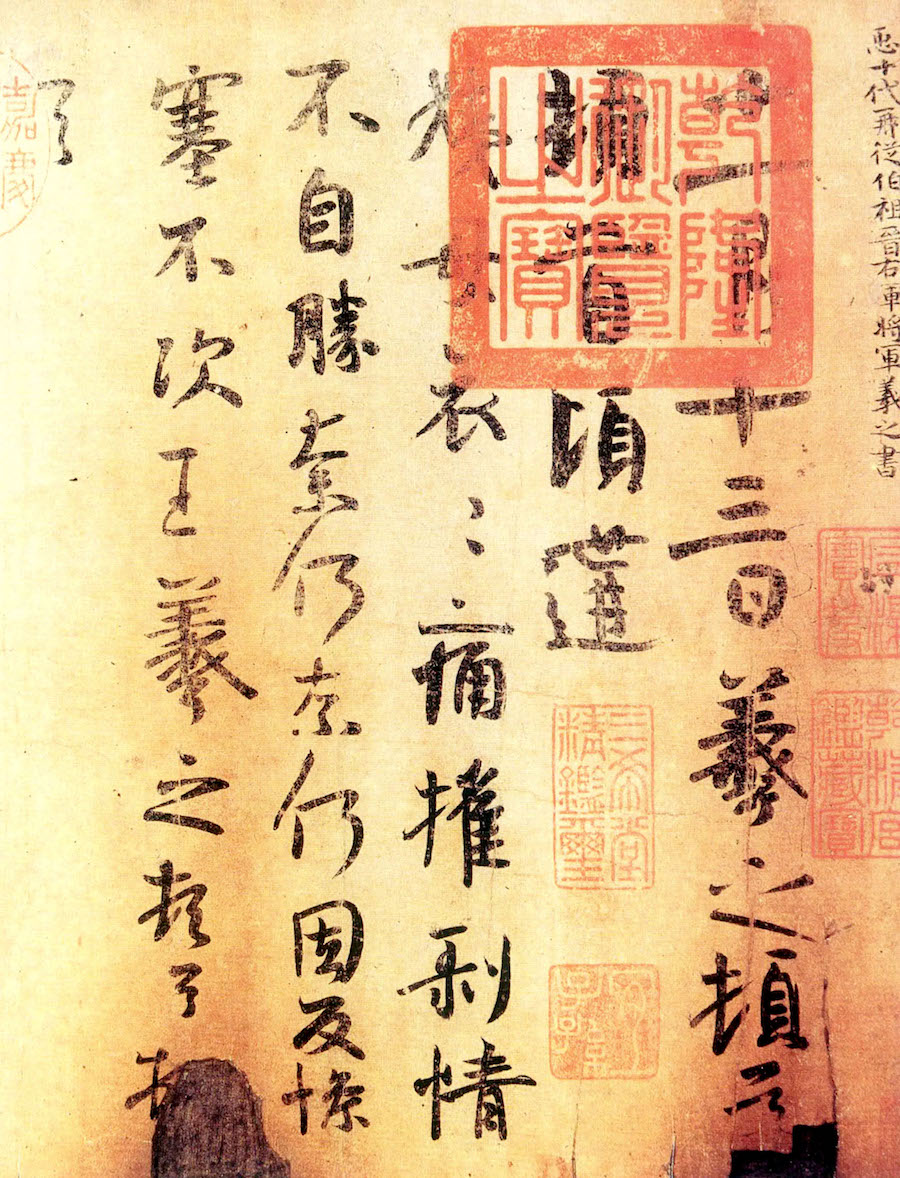
Eastern Jin Dynasty Wang Xizhi's "Aunt's Letter"
The "Sage of Calligraphy" Wang Xizhi has "Aunt's Note" and "Auntie's Note" handed down. "Auntie Post" wrote: " November 13, Xizhi's head and head. Suddenly aunt grief, grief torn and stripped, and her feelings are overwhelmed. No matter what! Look, after Wang Xizhi suddenly got the bad news from his aunt, he was so sad that he couldn't even handle normal affairs. The brushwork is simple, round and vigorous, and the characters are broad, thick and dignified. The style of writing is quite different from Wang Xizhi's various handed down copies because of the style of the asana, and most scholars believe that this post is the work of Xizhi in his early years. From the point of view of the text, "Auntie Post" seems to be incomprehensible and needs further scrutiny. From the point of view of brushwork and glyphs, it is already a brand-new style, smooth and elegant.
Wang Xizhi's "Aunt's Letter", Eastern Jin Dynasty
The "Houmuwu" Dafang Ding is the largest bronze vessel ever found in the world. Originally interpreted as "Simuwu". These three characters are cast on the inner wall of the abdomen. The font is strong and vigorous, the body is plump, the strokes are more sharp at the beginning and the end, and fat brushes are used between them. There are two explanations: one is that "si" reads "sacrificial", "muwu" is the temple name of the mother of Shang Wang Wending, and the tripod was cast by Wending for the sacrifice of his mother; the other is "si" meaning "later". ", indicating that the owner of the tomb was the "Queen" of the King of Shang before his death. In 1976, the stepmother Xin Ding was excavated from the Fuhao tomb at the Yin Ruins in Anyang. Shi Zai Fu Hao was the queen of Shang Wang Wu Ding. The Empress Wu Ding is a sacrificial vessel made by Shang Wang Zu Geng or Zu Jia to worship his mother Wu. In this way, the first word is not "si" but "later". The "stepmother" here is not a "stepmother" in the usual sense.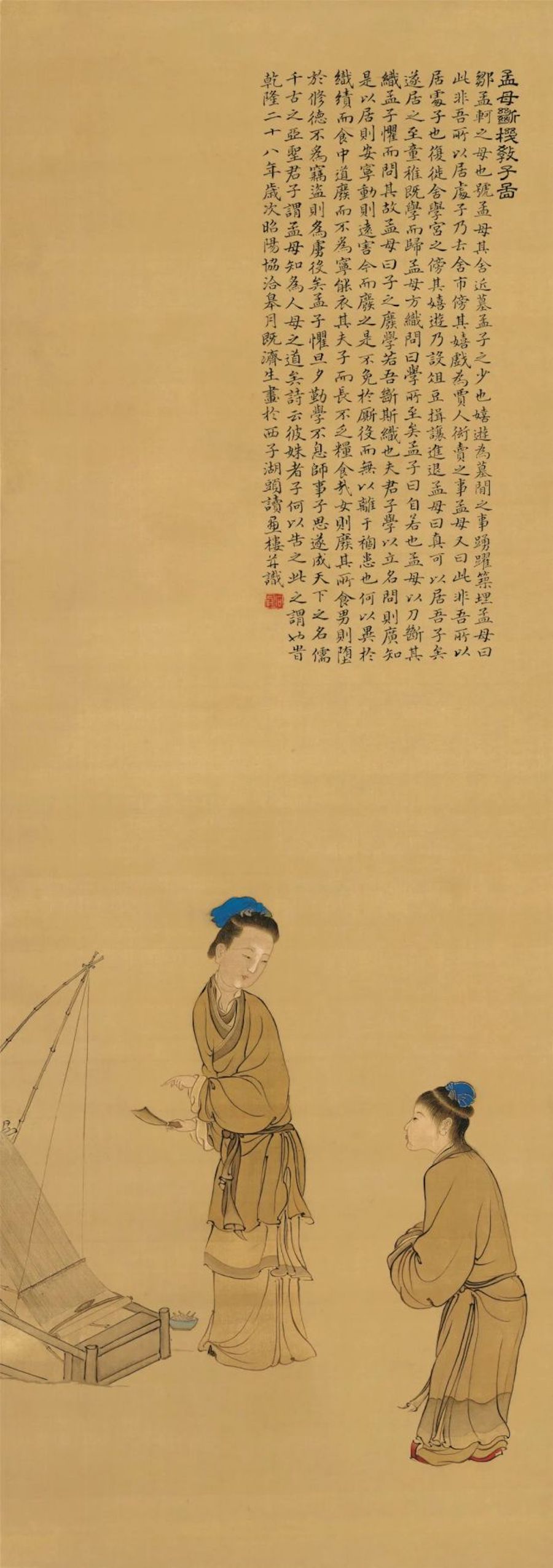
Qing Kangtao's "Meng's Mother Breaking the Machine and Teaching the Children" in the collection of the Palace Museum, Beijing
In Chinese culture, the idioms related to "mother", such as rebirth parents, food and clothing parents, kindness to parents, rebirth parents, mothers honor the world, mothers are precious to their children, good wives and good mothers, mothers are kind and filial to their children, etc. What is impressive is also the story of the "Four Great Mothers". Among them, Meng's mother moved three times and served the country faithfully, but painting Di teaching her son and cutting hair Yanbin are relatively unfamiliar. The former is Ouyang Xiu, and the latter is Jin Dynasty. Tao Kan's mother. The most influential story is the story of "Meng's mother moved three times", and Kang Tao of the Qing Dynasty painted "Meng's Mother Breaking Machines and Teaching Children Picture" based on this allusion. Looking at this painting, Mother Meng is standing sideways beside the loom, fingering the machine in her left hand and holding a knife in her right hand, her expression is solemn, as if she is teaching. The author inscribed in regular script the content of Meng's mother's three moves to choose neighbors and cut opportunities to teach her son in "Biography of Lie Nu": "Mencius was afraid, and he studied hard every day, and he thought about what he taught his son, and he became a famous Confucian in the world. You know the way to be a mother. The poem goes: 'The son of the scorpion, why tell him?' At the bottom right of the picture, Mencius faces his mother, bows his body and lowers his hands, and stands respectfully. His focused expression contains deference and respect for his mother. After listening to it, he thought about it, and after studying hard and studying hard, he eventually became a generation of sub-sages. The inscription is a standard pavilion, and its "pavilion" is a rigorous appearance, and there is no craftsmanship. As far as painting techniques are concerned, there is nothing special about it, it is simple and natural, the lines are skillfully used, the figures are simple and elegant, the cyan on the headscarves of the mother and the son and the use of cinnabar on Mengke's shoes are harmonious and natural without any jerky feeling. The structure of the loom is meticulous and subtle, and the colors are elegant. The ingenious composition and precise use of the pen make the characters vivid on the paper. The main focus is realism, and the content is greater than the form, which meets the requirements of the theme creation.
Qing Kangtao's "Beautiful Mother" in the collection of the Capital Museum
Reading Kang Tao's painting "The Picture of a Good Mother", I can't help but think of the allusions of "mother-in-law tattooing". The son was about to leave home to take up his post, and his mother did not forget to give him a serious admonition. The painter uses a very superb brushwork to express the scene of a virtuous mother teaching her son vividly. At the same time, he also vividly depicts the sad state of the mother when the mother and son are parting, and the reluctance of the daughter-in-law standing by the side to her husband. The hesitation of a son who respectfully listens to his mother's teachings. The words on the screen in the center of the picture are exactly what the mother told her son--" Listen to the prison, Zhuang Yigong. Don't be happy when you are sad, and be loyal when you are filial. " The bed and the screen form a sense of hierarchy from near to far. The painting style is rigorous, the coloring is light, and it has a strong artistic appeal.The most famous poem about mothers is undoubtedly Meng Jiao's "Wandering Son's Song": "The clothes of a wandering child in the hands of a loving mother. Before leaving, there are dense seams, and the night is afraid of returning late." The title of the "Mother Picture" painted by Qing Qian Hui'an is exactly the content of this poem. Different from other "Playing Babies", judging from the pictures, it can basically be determined that it is an ordinary person's device. However, the mother's love for her son is vividly on the paper. A mother's love is selfless, whether rich or poor.
Wang Juzheng's "Spinning Wheel" was purchased by Zhao Mengfu in the Yuan Dynasty, so he named it. This painting depicts such a vivid scene: in the spring, under a big willow tree, two women are spinning thread before a spinning wheel, the young mother on the right keeps spinning the spinning wheel in her right hand, and in her left hand is holding a baby who has just grown some hair . Zhao Mengfu wrote a poem for this painting: "The Tian family is working hard, and the chariots are rolling. " As said in the poem, the farm life in ancient times was busy and difficult. This young mother should not only do the work in her hands well, but also To breastfeed the child in her arms, she is busy for a moment. I wonder if the little boy behind her is playing with a frog tied to a small pole. Can you feel the hardships of a mother at this moment? This is also the true portrayal of all the mothers in the world working hard! The characters are naturally gathered and dispersed, and the objects in the picture are portrayed with precision and realism, especially the clothing patterns of the characters. The "war brush strokes" are used, and the strokes are in the center. It twists and turns with the changes, so as to accurately shape the figure's shape and the soft texture of the clothing.
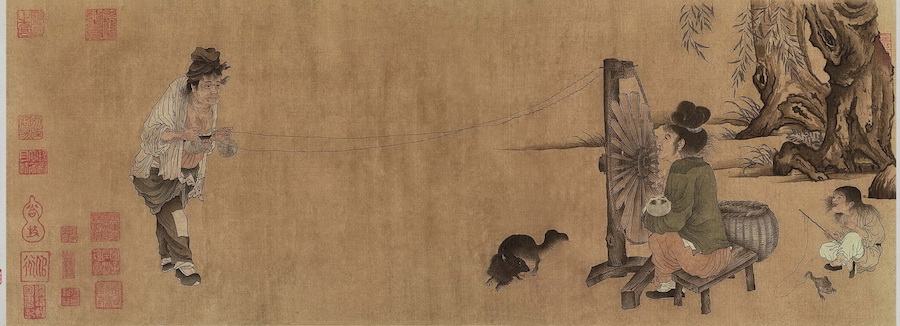
Wang Juzheng's Spinning Wheel in the Northern Song Dynasty, now in the Palace Museum
Contemporary master Lin Fengmian painted "Splitting the Mountain to Save Mother", which is derived from the allusion of Agarwood to save her mother in "Lotus Lantern". Lin Fengmian painted the theme of Chenxiang rescuing his mother again and again, which was related to his painful memory of losing his mother when he was a child, and poured out many strong emotions such as his desire to rescue his mother from a tragic fate and his hope for the reunion of mother and son. Lin Fengmian began to create opera paintings around the 1950s, and gradually explored a new modeling language, which perfectly combined traditional Chinese opera and Western Cubism expressions, which opened the way for the development of Chinese modern art. a new direction. It can be said that in the development and transformation of modern Chinese painting in the 20th century, Lin Fengmian's opera figure paintings and their modeling theory occupied an important position. It spans the gap between tradition and modernity, and has made unprecedented breakthroughs in the relationship between color and form structure, space and time. The colors of the picture are mainly dark blue and ochre yellow, and the dress of the three virgins is painted with dark blue and heavy ink, and then a translucent light white gauze is painted along with the elegant dance movements, which reduces the heavy feeling of the picture; agarwood Covered in warm colors, it forms a warm and cold contrast with the Three Madonnas, implying the meaning of salvation. The geometric golden background in the back has strong light and shadow, which highlights the situation of the two people. The bright background also makes the foreground characters have a backlight effect, extending the rich spatial depth. Using two different art forms as carriers, Lin Fengmian discusses the relationship between form and content, the continuity and opposition of time and space, and other modern themes.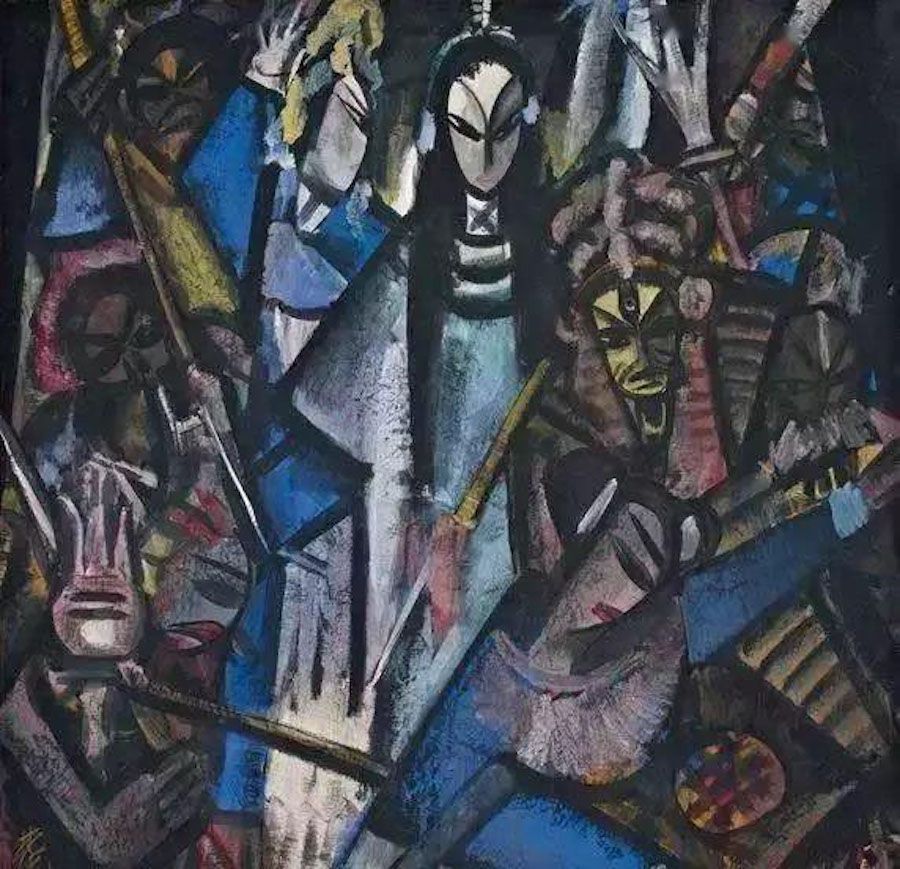
Contemporary Lin Fengmian "Splitting the Mountain to Save Mother"
In the Southern Song Dynasty, Li Song's "Trademan" is very grounded in conception, and the scenes commonly seen in the countryside are presented in the artist's pen. The merchant was carrying a load, and the baskets at both ends of the load were full of various items. The children had different expressions and were all happy. The joy of seeing all kinds of gadgets was inexplicable. No one has ever had such an innocent time. On either side are two plainly dressed mothers. The mother on the left supports the child with her right hand, and keeps her eyes on the child with loving eyes, for fear of accidentally falling him. At the same time, she selects the items he likes for the child in front of the basket. Seeing the child is happy, her heart is also very happy. joy. Isn't the mother on the right not in this mood? With a child in her arms, she was surrounded by two other children, and she could also read the loving kindness from her demeanor. Qianlong's inscription: "It is exhausting to carry heavy burdens on one's shoulders, robbing children of labor and support. Don't laugh at the fact that the goods are so stupid, who in the world is not like a fool?" To the extent that it is as good as the real thing. The writing is dignified, the closing is steady and powerful, the density and fineness can be expanded with ease, and the coloring is simple and elegant.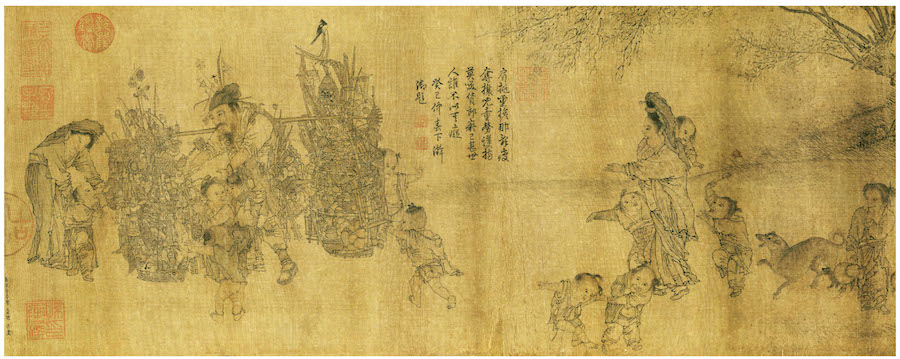
Southern Song Dynasty Li Song's "Trademan", now in the Palace Museum
Jiang Shiquan, a dramatist in the Qing Dynasty, lived with his mother, Mrs. Zhong, since childhood. His father was away all year round, and he mainly depended on his mother to weave and make clothes to make money to support the family. Jiang Shiquan, who grew up, described his mother's hard-working and virtuous life in "The Story of Mingji Night Class", and left a poem "Arriving Home at the End of the Year": " The heart of my beloved son is endless, and the joy of returning home is the end of the day. Letters and ink marks are new. We meet with pity and thinness, ask our children for hardships, feel ashamed of the son of man, and dare not sigh in the dust. " Delicately depicts the mother's love for her son. This kind of beautiful meaning is perfectly presented in Sha Fu's "Machine Sound Night Lesson". This theme painting depicts an autumn night. In the main room, the mother Zhong is weaving in front of the loom, and her daughter-in-law is standing behind her. It was Jiang Shiquan who observed and studied while studying hard and thinking in the study. The whole picture is dominated by turquoise, the brush is delicate and the coloring is elegant. The banana leaves are flourishing and green, and it is obviously summer time. The courtyard at night was extraordinarily quiet, only the sound of the mother weaving, while in the other room, the son was studying hard. What the mother does is to "accompany" and work hard without complaining.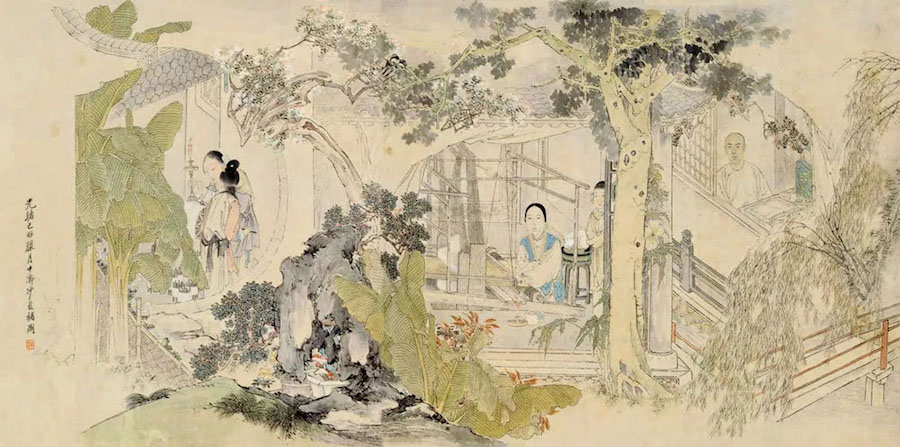
Qing Shafu's "Machine Sound Night Lesson" in the collection of Nanjing Museum
Zhu Xi, a great philosopher and educator in the Song Dynasty, unfortunately his father died of illness when he was fourteen years old, and his mother worked alone to make a living. The young Zhu Xi studied hard and never slackened. Whenever he had free time, he helped his mother to fertilize and grow vegetables to reduce her mother's burden. After Zhu Xi grew up, he never forgot his mother's teachings and nurturing grace, and he devoted himself to his mother. Zhu Xi once wrote poems to express his love and blessings to his mother, " I would like to thank my mother again before Xi, and since ancient times, I have done good things and brought auspiciousness. I hope that every year will be like today, and Laolai's mother and son will roam. " Yan created "Song Confucian Poetry Intentions" according to the general idea of the poem. The old mother in the painting is sitting in the house, and the family members are serving them obediently, showing a happy atmosphere of a mother's kindness and filial piety. Hua Yan is worthy of being a great artist in painting figures. Although he is a hut with a grass fence, he can appreciate the elegance and tranquility, but not the frugality of frugality. As a generation of painters, the admiration and admiration for the Confucian masters in history, although it is a thousand years old, has a spiritual resonance.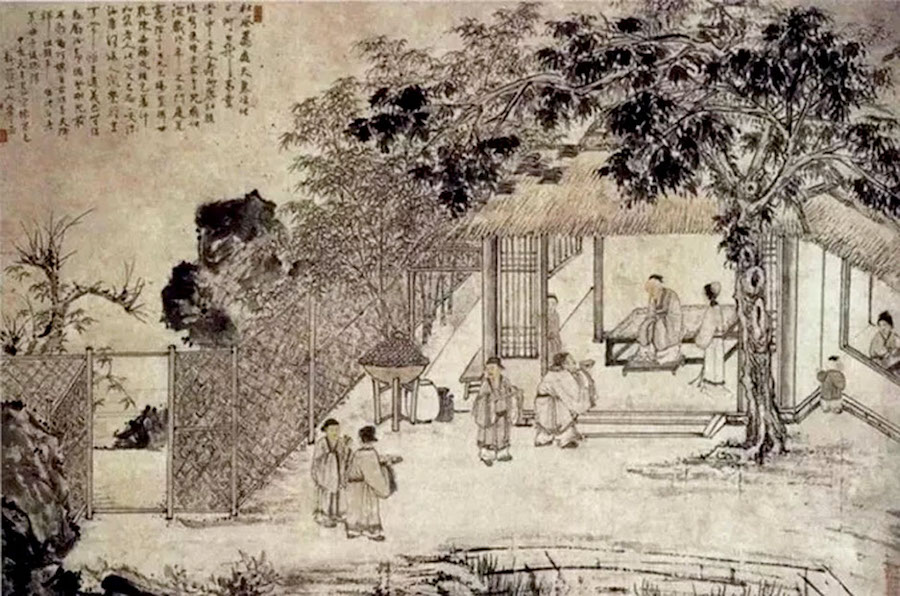
Qing Huayan's "Song Confucian Poetry Intentions"
Zhao Zhiqian and Huang Shiling created the seal "Villain has a mother" for their friends. Zhao Zhiqian's seal was engraved by his friend Wei Jiasun. The words in the paragraph say " If there is filial piety, it will be fulfilled ." The border of this seal is broken, and the shape is incomplete. The four characters are all long lines, elegant and agile, soft but not flattering. From the changes in seal and adhesion, we can see Zhao Zhiqian's superb skills. Huang Shiling was also engraved by a friend, and the inscription indicated that it was Wang Xuecheng. In terms of swordsmanship and seal art, it is beautiful and elegant, and it has the meaning of imitation. The knives are strong and neat, and the straightness of the word "small" forms a strong contrast with the curved shape of the word "mother". The combination of Zhangfa and the magic, especially the adhesion of the word "human mother", compared with the thickness and radius of the sidebar, it is admirable.As the saying goes, "mother and son are connected to the heart", and there are many works of this kind in the past dynasties.

Qing Renyi's "Nong Zhang map" in the collection of Tianjin Art Museum
One of the "Four Masters of the Shanghai School", Ren Yi's "Nong Zhang Tu" shows the intimate interaction between the child and the mother, and successfully demonstrates the intimacy between the mother and the child in ancient society, showing the most tender maternal love. "Nongzhang" is an ancient Chinese name for giving birth to a boy, Zhang refers to a kind of jade, and giving birth to a girl is called "Nongwa Zhixi". Ren Bonian's figure painting can be called a must, and he is the leader in the "Shanghai School". Learning painting since childhood, not only has a deep understanding of national traditional art, but also mastered certain Western painting skills. Therefore, the drawing of "Nongzhang Tu" not only combines the essence of Chinese freehand painting, but also shows the hidden hidden in the painting. The warmth in the painting. The scene in the picture is not real life, but is conceived by imagination. The pine branches and rocks, the mother is sitting, and a child is leaning on her lap. The family is happy and happy. Although the scene is "virtual", the mother's love is real. There are inscribed comments on both sides: "Wei Chang's pen is elegant, and you can look down on the future", "You enter the ancient times, and it is suitable for him to follow the heart of Jindong".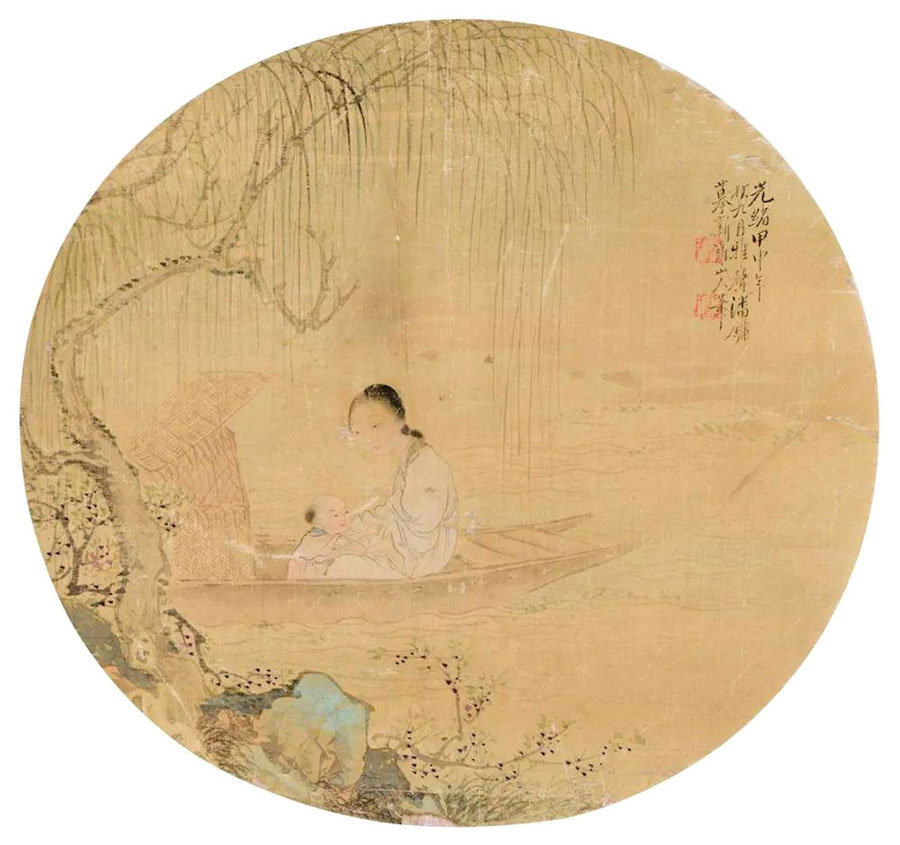
Qing Pan Yong's "Mother and Child" fan
Another scene shown in Pan Yong's "Mother and Child" fan. On the autumn boating lake, the mother takes her child to play, the soft willows and the small flowers, the light boat and the fine waves, combine to form a beautiful scenery of the south of the Yangtze River. With delicate brushwork and beautiful style, it perfectly presents the serenity of mothers and the innocence of children.
Song Anonymous "Picture of Son and Hen"
The ancients called chickens "German birds". Because chicken is homophonic with "ji", it is often regarded as a symbol of good luck, so there are painting creations that use hens and chicks to express the relationship between mother and child. Song Anonymous "Picture of Son and Hen" is a feather sketch in the Southern Song Dynasty. There is a hen in the picture, which is huge compared to the five chicks. Five chicks gather around the hen, and follow the hen in the field, in different postures. The hen's snow-white feathers are fluffy and bright, and her eyes are full of love, while the chicks are tender and timid, snuggling under the protection of their mother's wings. The hen leaned over and looked sympathetic. The shape of each chicken is accurate and the proportions are well-proportioned, especially the slack feathers of the hen, the look of bowing and pecking and whistling, the state of the four chicks in front of them swaying, and the chicks that are about to emerge from the back of the hen's neck. Showing the delicate state of the shell at the beginning, it is vivid and vivid, and fully demonstrates the realistic skills of the Song people. The most subtle is the author's treatment of the hen's eyes, leaving the blank position in the front of the eyeball, making it more intense. This is probably part of the reason why Emperor Chenghua of the Ming Dynasty was moved when he admired the Song painting "The Son of a Hen", and left an inscription poem: "Nanjing Zhe is from other groups, and the grass-roots and earth caves can be divided. There is no twilight, covering the body and snoring with the sun. Raising the feathers and pecking by drinking, defending the young and juvenile is the total meritorious deed. Pittu sees the Erpin, and the German enterprise Ciwu is known to the world.” The whole poem describes the hen to the young. The love of chickens is written vividly. The brushwork is light, the iron is painted with silver hooks, and there is a vague sense of cursive brushwork, which adds to the interest.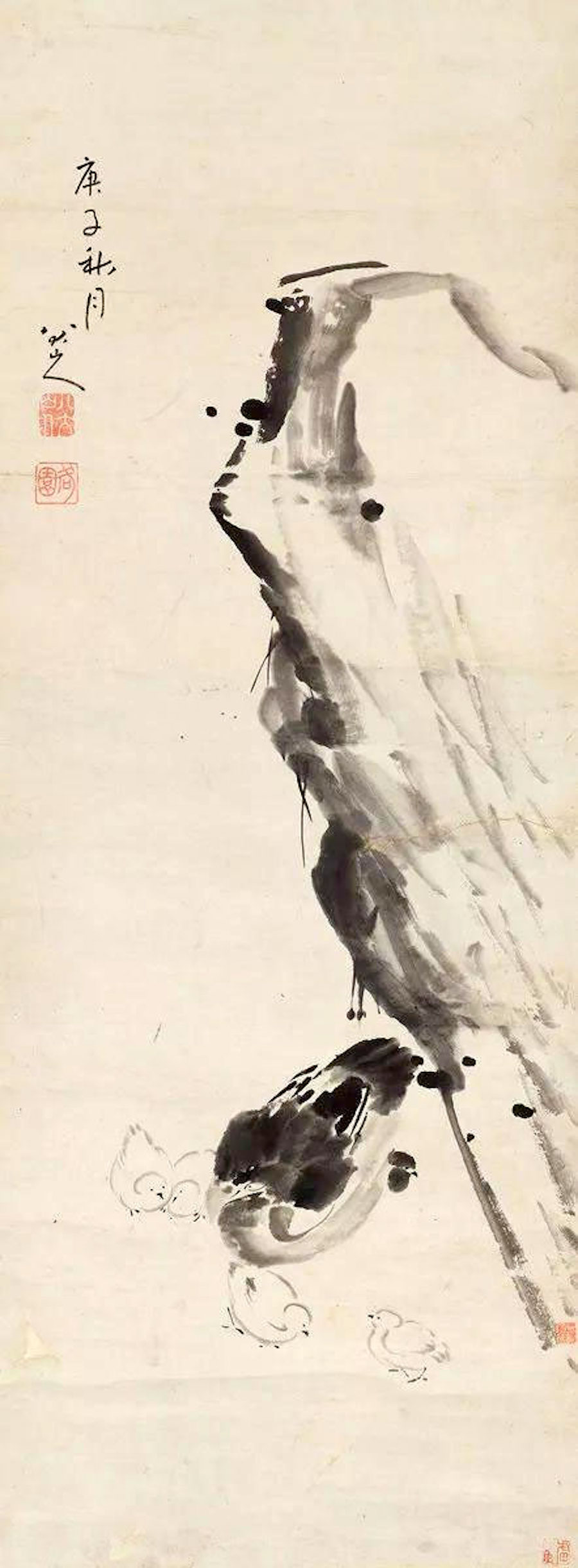
Qing Dynasty Bada Shanren "Mother and Child"
The "Mother and Child" by the Eight Great Shanren of Qing Dynasty was painted in the autumn moon of Gengzi, that is, in 1660, when Shanren was 46 years old, in his prime. This is the creation of the bland and innocent style highlighted in the eight works. As an artist, the idea is extraordinary. A boulder with a tendency to tilt to set off the "smallness" of the hens and chicks. The outline is large, and the light is dry, and the contrast between the shades is obvious. The hen is lying down, and the four chicks are walking around very happily. The hen uses dark ink and heavy ink, and the chick is light ink, which forms a sharp contrast and enjoys the joy of mother and child reunion.I remember Mr. Lu Xun said: "Even a genius, the first cry when he is born, is the same as that of an ordinary child. It will never be a good poem." It was the loud cry after the baby was born. The birth of a child is described as "creeping", and from the moment the baby is born, the whole world lights up! Even if you are an imperial family, you will cherish this initial family happiness. "Spring Dawn in the Han Palace" is a masterpiece by Qiu Ying. With the theme of the Han Dynasty court in the morning light of spring, he depicts the beauties of the harem in the form of a long scroll. In the painting, there are 115 people, including concubines, palace maids, princes and painters, all dressed in bright clothes and in different postures, both idle and busy. commonplace. In addition to the group portraits of various ladies, various literati-style leisure activities are also incorporated, such as singing, playing around the fireplace, playing chess, reading, viewing paintings, images, playing with babies, swinging fans, etc. Qiu Ying's aesthetic concepts and tastes were influenced by the literati at that time, and the subjective interest was combined with the natural environment. The background of the picture includes high platforms, pavilions, green trees and jungles, gurgling water, birds and flowers, etc. The overall rendering of the realm of elegance and tranquility, showing everywhere. The humanistic thought of people being positive and loving life, the "Han Palace" symbolizing its prosperity and prosperity, and the "Spring Dawn" that leads to infinite reverie.
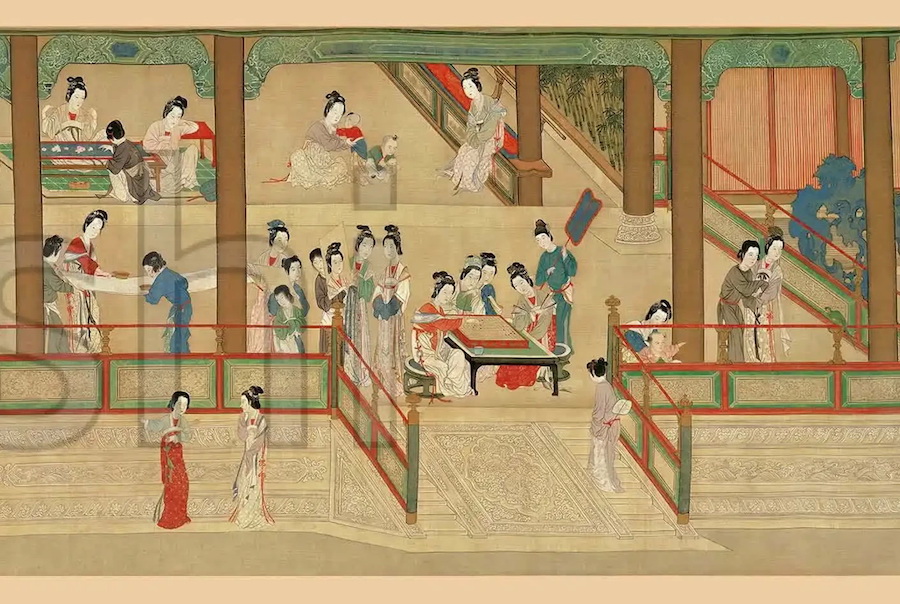
Part of Qiu Ying's "Spring Dawn in the Han Palace", Ming Dynasty, now in the collection of the National Palace Museum, Taipei
The silk version of Zhou Fang's "Playing Babies" is a copy of the Song Dynasty. The techniques and colors are in Zhou Fang's style, retaining many characteristics of figure paintings from the Five Dynasties to the Northern Song Dynasty. The drawings are obviously the portrayal of wealthy people. The life scene of five women playing with seven young children, bathing and dressing the children. Above are two women bathing and shampooing the child. A naked child in the bathtub is learning to scrub his head and neck with his small hands. An urchin standing behind the tub seems to be trying to tease him. The picture on the right shows a woman playing with two children. One child sits and stretches out his hands to take something from the woman, while the other child gives up the toy he is playing and stretches out his hand, intending to fight. The two women on the left are dressing their children. The three sets of pictures do their own thing, but they echo each other. The combination of adults and children in each group has its own characteristics, especially children, standing, sitting, prostrate, or lying on their backs, showing their cuteness.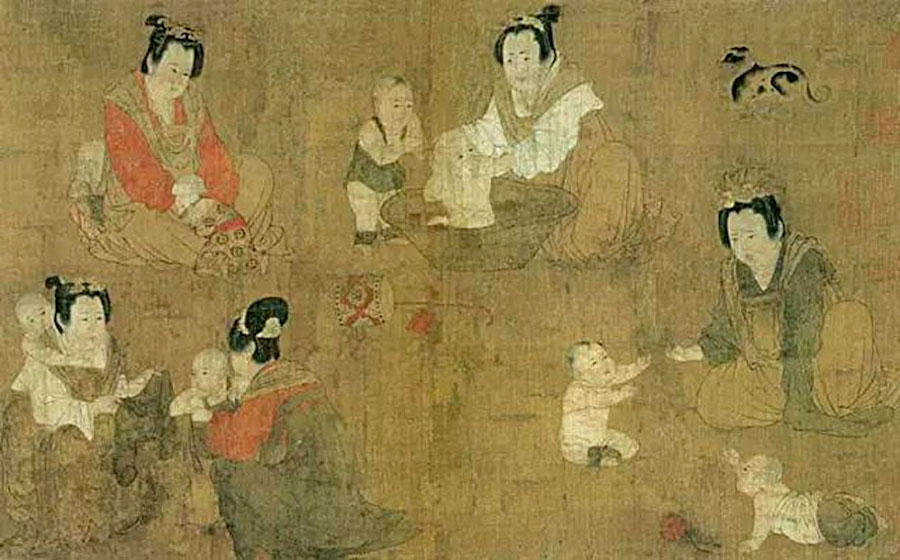
Song Anonymous imitating Zhou Fang's "Baby Playing" Now in the Metropolitan Museum of Art
Ordinary people cherish and enjoy this rare cuddling feeling even more. Song Anonymous "Baby Bathing" depicts exactly this scene. The word "Zhou Wenju" outside the picture is added later, and this work is regarded as the work of the Song Dynasty. There are three women and four children in the picture, with a long bathtub in the middle. The ancients believed that bathing can transmit the power of water to breed all things to babies, so that they can grow up healthily. From this point of view, bathing has ceremonial and even religious connotations. If you look closely, the three women are clearly distinguished in their dress and posture. Regardless of clothing, hairstyle or posture, the woman in the middle of the painting squatting beside the tub to bathe a child is in the same group as the woman on the right of the painting dressing or undressing another child. Their dresses are both white and blue, and they all have hairstyles similar to those of Tang Dynasty buns, and they are all squatting on the ground. The colors of the picture are elegant and lively, the atmosphere is warm and harmonious, the woman's expression is kind and the baby's innocence is full of rich human feelings and practical significance.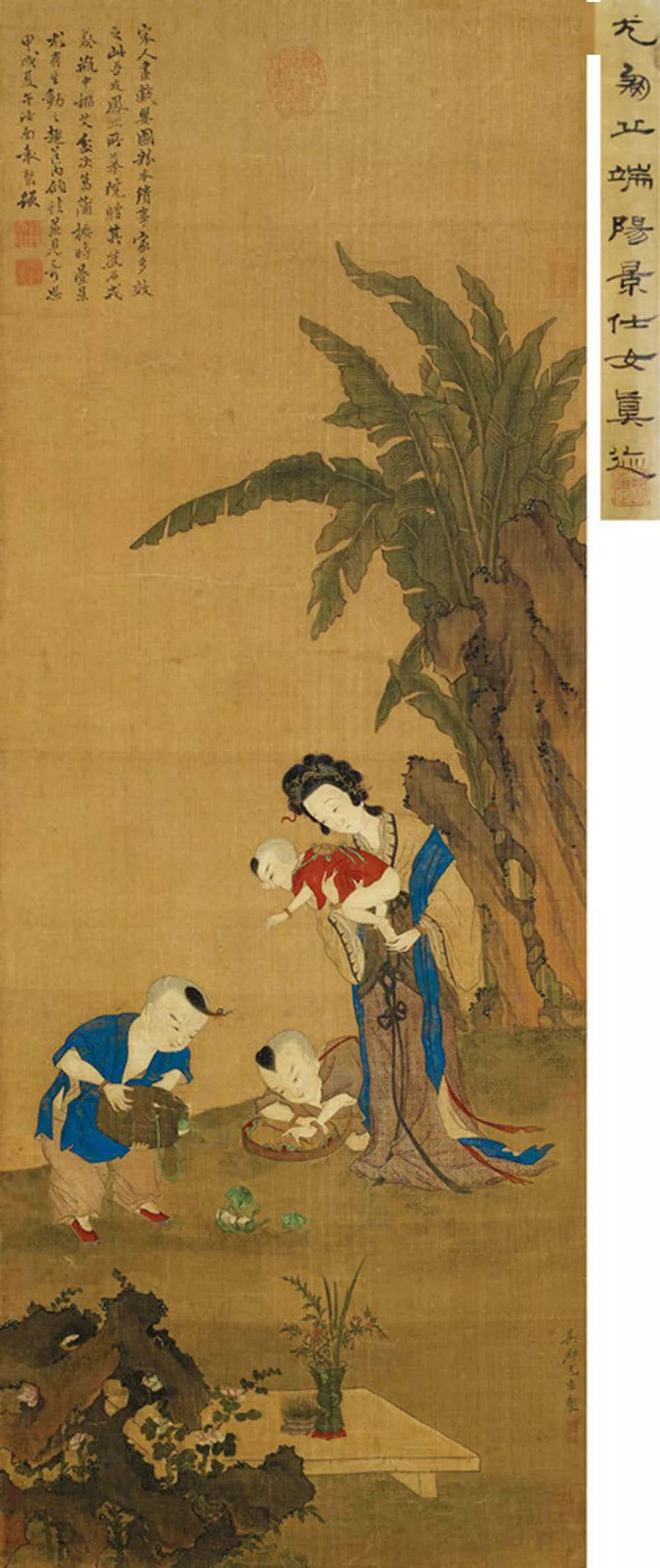
Ming Youqiu "Playing Baby Picture"
In particular, Qiu Gong wrote landscapes and characters, and learned from Liu Yingnian and Qian Shunju, but he was not as subtle. She is also a long lady and the most famous figure painter after Qiu Ying, especially good at line drawing. "Playing Babies" was created by You Qiu on the day of the Dragon Boat Festival. Although it is "Playing Babies", it mainly simulates the body painting of the Song Dynasty, with a classical temperament. style. The mother in the picture is dignified and gentle, holding the baby in her hands, bending her body to suit the child's posture. There is a slight gap in the ages of the three children. They stand, lie down and hug each other, forming a combination of contrasts and clever ideas. Because it is the Dragon Boat Festival, the background colors are mostly the scenery of the occasion. Dress brightly, with strong color contrast, and appropriate movement and stillness.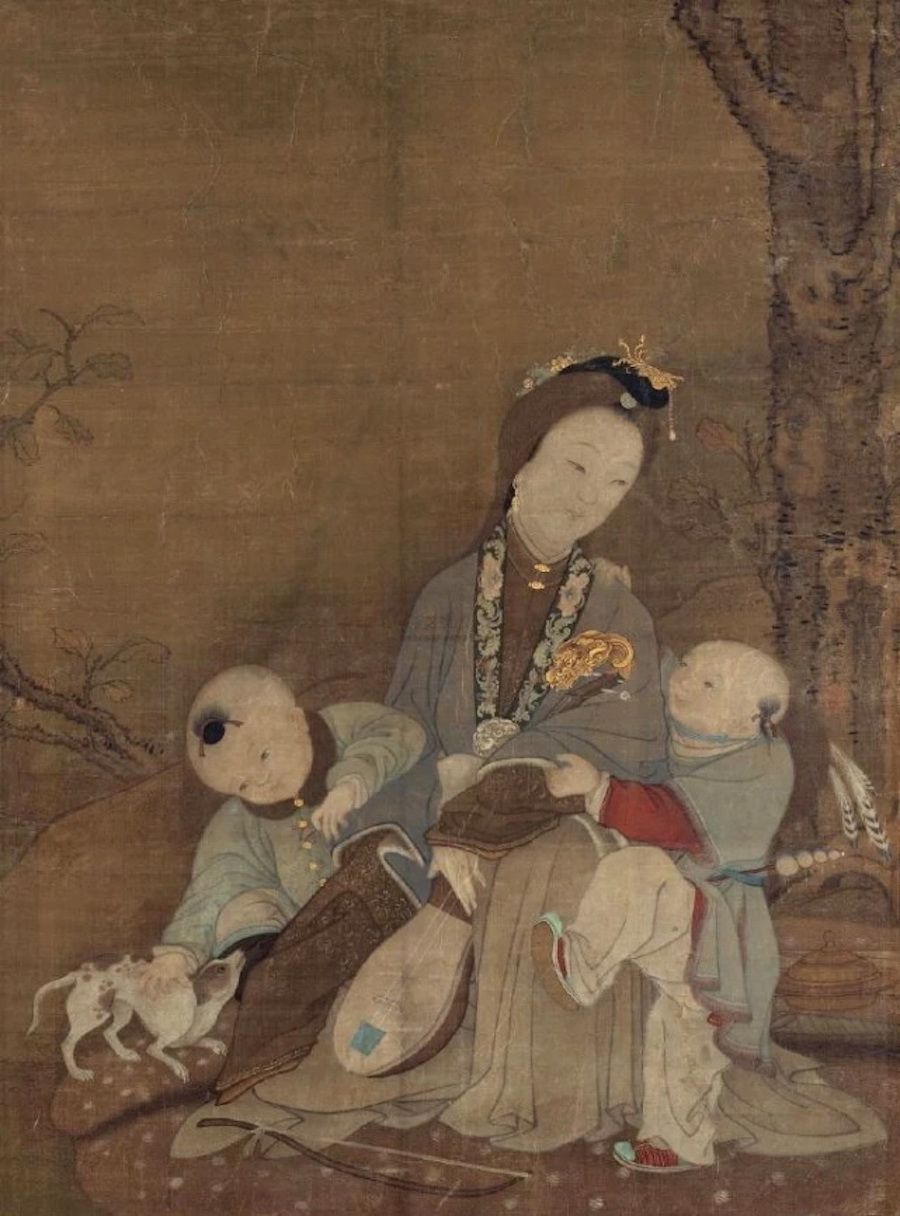
Qing Leng's "Baby Play Picture"
Leng Mei, a disciple of Jiao Bingzhen, is good at painting figures and borders, especially the fine ladies, and the workmanship is elegant. The brush and ink are clean, the colors are beautiful, the painting method is also the work of writing, and the house utensils are embellished. . Leng Mei also absorbed some Western painting techniques, such as perspective, distance, light and shade, and contrast in sketch paintings. "Baby Playing" has different tones and different attitudes. In terms of techniques, it has the effect of photos because it absorbs Western painting techniques. The mother is dignified and kind, the two children are on one side, and their expressions are different. The mother stares affectionately, with a look of love.I can't help but say that the word "play" is the most expressive. Xin Qiji has a famous saying "I like children's rogues the most, lying on the stream head and peeling off the lotus pods", which is even more interesting in life.
Feng Zikai once wrote "My Mother": " My mother sat on the chair of the Eight Immortals in the northwest corner of my old house, her eyes glowed with seriousness, and the corners of her mouth showed a loving smile. When I was 30 years old, She gave up her job and returned home to read and write to her mother, but her mother still sat on the chair of the Eight Immortals in the northwest corner every day, with serious brilliance in her eyes and a loving smile on the corners of her mouth. However, her hair had gradually turned from gray to silver. ” The mother painted by Feng Zikai is graceful and quiet, gentle and kind, giving people a kind of affection. The paintings of "Little Brother Is Asleep" have the nature of comics. These four paintings are of a combined nature and have the function of reproducing movie scenes. They vividly portray a child's innocence and attachment to his mother. Mothers will do their best to meet the demands of their children. The intimacy of mother and son reflects the warmth of the world.
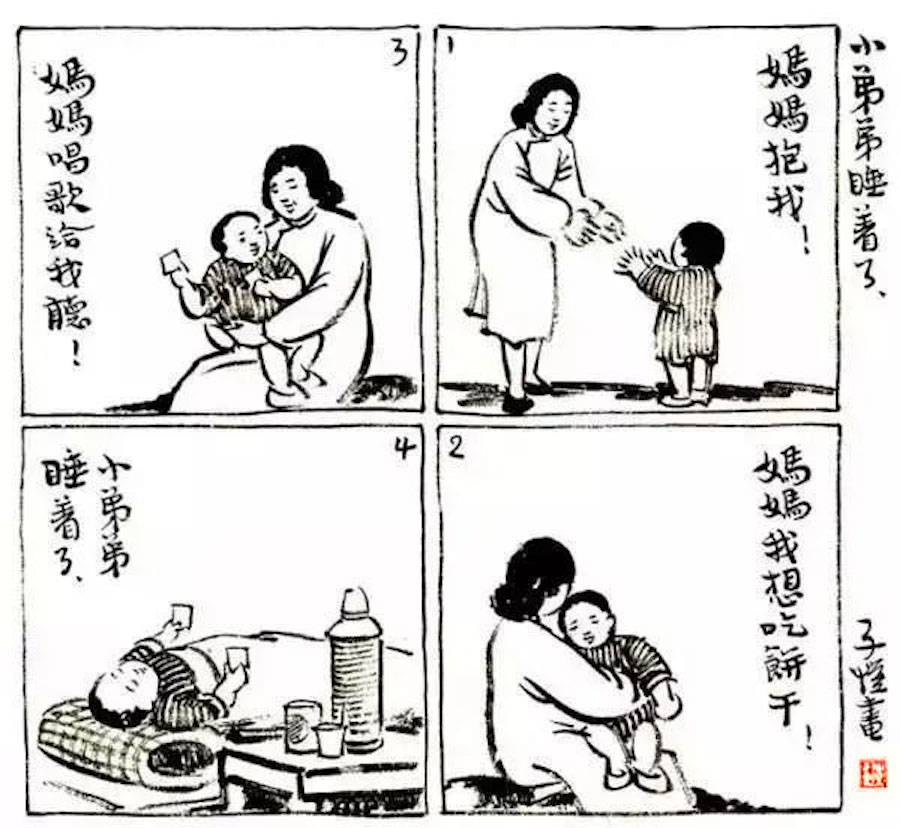
Contemporary Feng Zikai, "Little Brother Is Sleeping"
Contemporary Huang Zhou's "Nursing Babies" is full of interest in modern life. Huang Zhou grew up in a passionate age full of lofty ideals and heroism. His life experience in the army and border defense areas for many years has nurtured his passionate and romantic artistic temperament. From the perspective of painting style, it should be a minority woman, vaguely feeling the style of the grassland. Huang Zhou has many similar creations in the long process of collecting wind. The use of color is unique. Huang Zhou's figure paintings are bold in color, and the composure of splashing ink forms a sharp contrast with the brilliance of colors; He not only absorbed the tone of color used in Western painting, but also boldly adopted the treatment method of folk color, without losing the charm of Chinese ink painting. Two vases, a kitten, a spinning top, and scattered flowers, seemingly random arrangements, perfectly present the child's carefree and innocent world.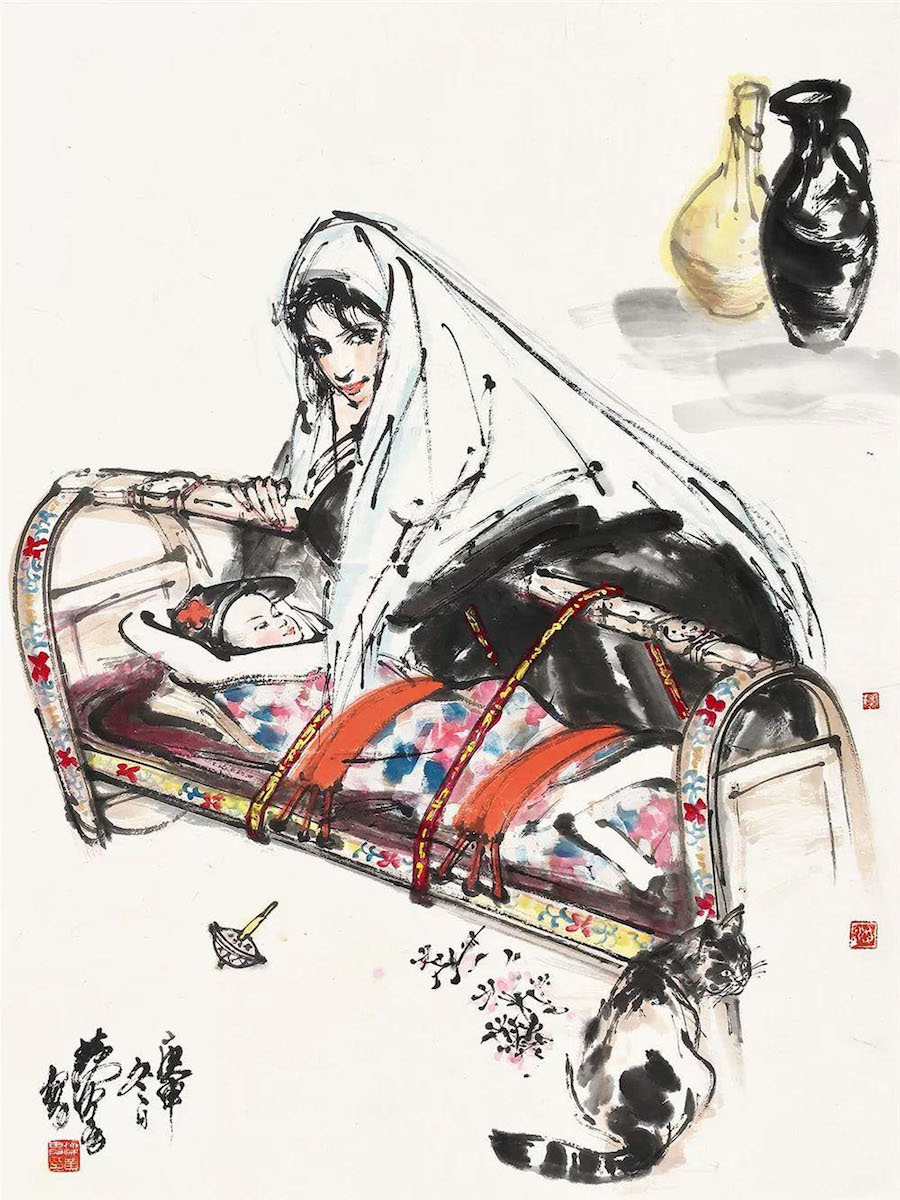
Contemporary Huang Zhou's "Parenting Picture"
So far, it can be seen that the theme of mother and mother’s love in Chinese painting and calligraphy is a rich series, which has witnessed the characteristics of Chinese painting that is both freehand and realistic, both heart and shape, me and him, and both fun and taste. . The sketching and realism of Chinese painting should not be regarded as a very special issue. It has always been the center of emphasis and implementation. Since the Qing Dynasty, Chinese painting has absorbed and learned some Western painting traditions, and has shown more realistic influences in character modeling and expression. With the change of the times, the creation of Chinese painting is not limited to the expression of specific themes, but gradually expands to a more comprehensive and broad direction. Changes in content and themes inevitably affect techniques, and multiple choices will break through the existing standards. , to bring forth new ideas. It can be said that Chinese painting, especially figure painting, can best adapt to the development of the times, expressing new life, new phenomena, new style and new achievements. When selected into a series, not only the theme is highlighted, but also the imprint of the changing times can be seen." Kaifeng from the south, blows the thorny heart. The thorny heart is young, and the mother's hard work. The triumphant wind comes from the south and blows the thorny salary. The mother's holiness, I have no one. … "Mother's love is the greatest and most beautiful of human beings. Selfless emotion, every step of everyone's growth, embodies the mother's countless efforts and endless care. Reading ancient calligraphy and painting, through the moving scenes in the handed down paintings, you can appreciate and feel the great, simple, real and deep maternal love.